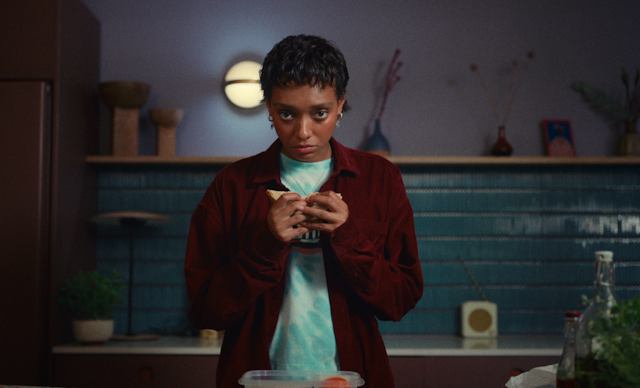Netflix couldn’t have chosen a more resonant title than Everything Now for their new comedy drama series. When I came out of a residential clinic in 2009 for treatment of anorexia, I did a parachute jump, started volunteering and decided to have a baby on my own. Some of these were impulsive – yet heartfelt – attempts to “catch up” on a life that had been passing me by.
This sense of things moving on while you have been trapped in the depths of an eating disorder is probably even more potent in the intensified temporal rhythms of teenage years.
As Mia Polanco (Sophie Wilde), the 16-year-old protagonist of Everything Now, asks as the school bus conversation jostles around her: “Fuck. How can I have missed so much in seven months?”

This article is part of Quarter Life, a series about issues affecting those of us in our twenties and thirties. From the challenges of beginning a career and taking care of our mental health, to the excitement of starting a family, adopting a pet or just making friends as an adult. The articles in this series explore the questions and bring answers as we navigate this turbulent period of life.
You may be interested in:
Friends with benefits – what a sex and relationship therapist wants you to know
Why are ‘photo dumps’ so popular? A digital communications expert explains
Everything Now is a thoughtful, sensitive and entertaining journey through Mia’s experience of teenage life following her discharge from the eating disorder inpatient unit she has been confined to for seven months.
The image of eating disorders
White, middle-class girls with anorexia have long since dominated the representation in film and TV. But eating disorders cut across ethnic boundaries.
Although there can never be any simple correlation between popular media representations of eating disorders and reality, they play a role in shaping wider understandings of eating problems. This includes who might be affected by them. As a result, this under-representation contributes to a culture in which people from minority ethnic backgrounds are under-diagnosed and less likely to access treatment.
Everything Now should be praised for recognising that it’s not just white, middle-class girls who experience eating disorders.

Also, a significant part of the early plot focuses on Mia’s crush on a female student. Historically, clumsy assumptions have supposed that LGBTQ+ girls and women are somehow more “protected” from eating issues than their heterosexual counterparts. This has long since been challenged. Research has shown that sexual minorities may be more at risk due to the complex relationships between oppression, gender identity and sexuality.
Read more: A male character on Heartstopper has an eating disorder. That's more common than you might think
Nuanced representation
Everything Now is one of the first TV shows about eating disorders that did not make me cringe. It is sensitive, carefully researched and it resonated.
The show does a good job of exploring the complexities of recovery – a long and uncertain process that is rarely depicted, perhaps because it is seen as less arresting than the descent into the illness.
Switching between flashbacks of her time in the clinic and her present life at school and home, Mia’s voiceover communicates her struggles and anxieties. It also shows how difficult it is to navigate other people’s perceptions of recovery. Her grandmother, for example, bakes her a coconut sponge to welcome her home, to which Mia internally exclaims: “You’ve got to be fucking kidding me.”

Her grandma then pinches her cheek and says: “You look so wonderful, so healthy.” The implied link between flesh and healthiness can make such comments a minefield for people in recovery.
Mia aims to throw herself back into adolescence, but the series poignantly explores her new status as an insider and outsider – how she is irrevocably changed by her eating disorder.
As the camera pans over the nibbles and drinks at a party she asks: “How can they just eat and drink? How am I 16 and I can’t just do that?” This captures the way spontaneity with food and drink becomes utterly unimaginable, not only during the throes of an eating disorder but during the pressures, regimens and routines of a recovery meal plan.
Representing recovery
The voiceover is particularly good at showcasing the disjuncture between Mia’s eagerness and how her eating disorder pulls the brake: “Shots, OK. At least I can track what’s in that. Maybe I can skip something tomorrow. I need to show them I’m better. That I can be normal.” She is both present and not present – one of her peers yet so separate.

Everything Now depicts positive moments of recovery too, in ways that are touching and insightful. As Mia walks to school for the first time, she reflects on “All the everyday beauty I forgot how to see – and all the things I get to rediscover now.”
While the eating disorder has made the everyday strange (the snacks and drinks at the party seem impossible) it has also made the everyday more beautiful. The scene reminded me of a quote from a student in sociologist Paula Saukko’s 2008 book The Anorexic Self: “I used to be able to see the sky, but now I only think about food.”
Everything Now is an original, heartwarming and insightful story of learning to see the sky again.

Looking for something good? Cut through the noise with a carefully curated selection of the latest releases, live events and exhibitions, straight to your inbox every fortnight, on Fridays. Sign up here.

